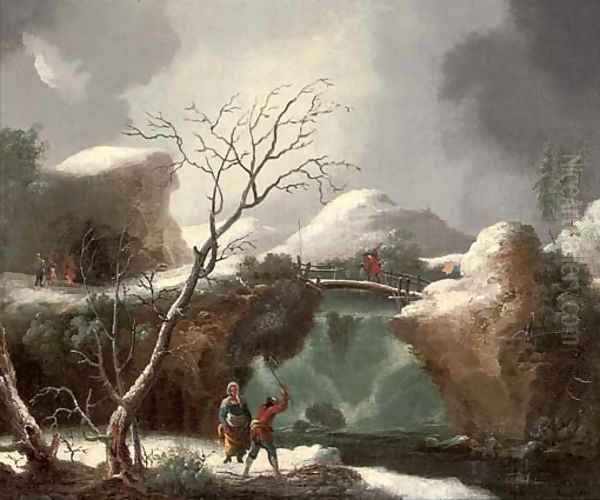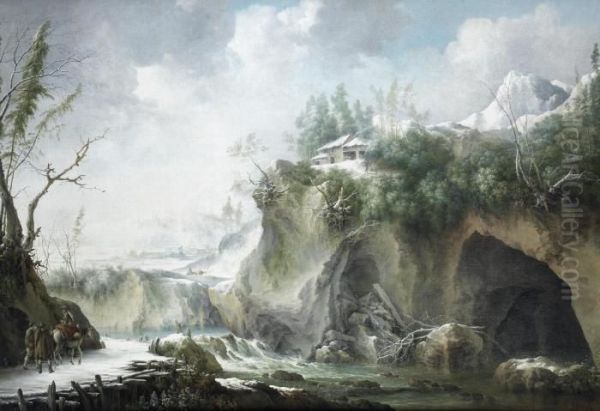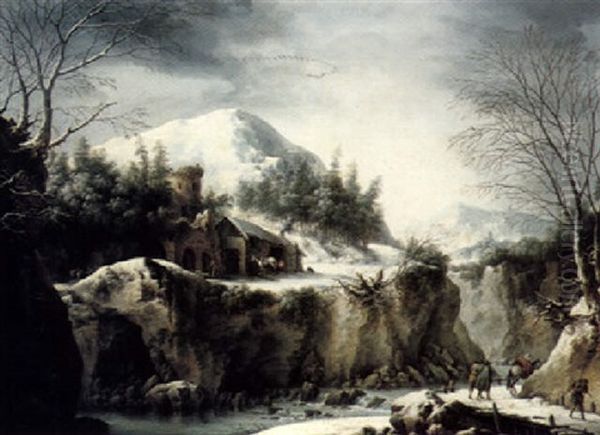
Francesco Foschi stands as a distinctive figure in the panorama of 18th-century Italian art. While Italy, particularly Venice and Rome, was renowned for its sun-drenched cityscapes and classical ruins captured by vedutisti, Foschi carved a unique niche for himself, becoming one of the foremost painters specializing in winter landscapes. His evocative depictions of snow-covered scenes offered a striking contrast to the prevailing tastes and established him as a master of a genre rarely explored with such dedication by his Italian contemporaries.
It is crucial, however, to distinguish this Francesco Foschi (1710–1780) from an earlier Florentine artist, Pier Francesco di Jacopo Foschi (1502–1567). The latter was a significant painter of the Mannerist period, known for his portraits and religious works, and a student of Andrea del Sarto. The information provided in various sources sometimes conflates these two artists, but this article focuses specifically on the 18th-century Francesco Foschi, the celebrated painter of winter.
Early Life and Artistic Formation in Ancona and Fano
Francesco Foschi was born in 1710 in Ancona, a city on the Adriatic coast of Italy, into a family of considerable means. His background provided him with opportunities perhaps unavailable to artists from more modest origins. The artistic inclination seems to have run in the family, as his brother, Carlo Foschi, also pursued a career as a painter, specializing in marine subjects, a fitting choice given their coastal hometown.
Foschi received his initial artistic training not in Ancona itself, but in the nearby town of Fano. There, he entered the studio of a painter named Mancini. While details about Mancini's own work are scarce, this apprenticeship would have provided Foschi with the foundational skills in drawing, composition, and the handling of pigments necessary for any aspiring artist of the period.

During these formative years, Foschi also benefited from the support of a local nobleman, Count Raimondo Bonacorsi. Patronage was essential for artists in the 18th century, providing financial stability and access to influential circles. Count Bonacorsi was not just a patron but also an art collector, and his collection reportedly included a series of twelve paintings by Foschi depicting scenes from Ovid's Metamorphoses. This early commission suggests Foschi initially explored mythological or historical themes before finding his true calling in landscape.
Roman Sojourn: Exposure to the Veduta Tradition
In 1729, at the age of nineteen, Francesco Foschi made a pivotal move to Rome. The Eternal City was a vibrant artistic hub, attracting artists from all over Europe. It was the era of the Grand Tour, and wealthy travelers flocked to Rome, eager to acquire paintings capturing the city's ancient monuments and picturesque views. This demand fueled the success of veduta painters, artists specializing in detailed topographical views.
In Rome, Foschi encountered the works of the leading vedutisti. The provided texts specifically mention his observation of paintings by Giovanni Paolo Panini and Gaspar van Wittel (often Italianized as Vanvitelli). Panini was renowned for his grand depictions of Roman ruins and contemporary festivals, often filled with numerous small figures. Vanvitelli, a Dutch painter who spent most of his career in Italy, was a key figure in the development of Italian view painting, known for his clarity and precise rendering of cityscapes and landscapes.
Exposure to these masters undoubtedly influenced Foschi's approach to landscape painting. He learned the importance of perspective, architectural accuracy (though less relevant for his later work), and the effective use of light to create depth and atmosphere. An early work attributed to him, the View of Loreto with Papal Portrait, housed in the Palazzo Apostolico in Loreto, likely reflects these influences, combining landscape elements with portraiture in a manner perhaps indebted to the Roman school. Although he would eventually specialize in a very different type of landscape, his time in Rome provided crucial technical and compositional grounding.
The Unique Specialization: Master of Snow and Ice
What truly sets Francesco Foschi apart is his decision to specialize almost exclusively in winter landscapes. In 18th-century Italy, a land associated with sunshine, classical antiquity, and vibrant city life, depictions of snow and ice were exceptionally rare. While Northern European artists, particularly Dutch and Flemish painters like Hendrick Avercamp or Aert van der Neer from the previous century, had established a strong tradition of winter scenes, it was not a theme commonly embraced by Italian painters.

Foschi made this niche his own, developing a remarkable ability to capture the specific effects of winter light and atmosphere. His paintings are characterized by a meticulous rendering of snow-laden trees, frozen rivers and waterfalls, and the soft, often cold light of a winter sky. He paid close attention to the textures of snow – powdery drifts, compacted paths, glistening ice – and the way it transformed the familiar shapes of the landscape.
His compositions often feature dramatic contrasts: the dark, intricate silhouettes of bare trees against the bright expanse of snow; the rugged forms of rocks emerging from the white blanket; the dynamic rush of a partially frozen waterfall. He frequently included small human figures, known as staffage, in his scenes. These figures – travelers huddled against the cold, peasants gathering wood, skaters on frozen ponds – serve multiple purposes. They add a narrative element, provide a sense of scale, and emphasize the relationship between humanity and the often harsh, yet beautiful, winter environment.
Key Works and Stylistic Hallmarks
Several works exemplify Foschi's mastery of the winter landscape. The Winter Landscape with Waterfall showcases his skill in depicting both the stillness of snow and the movement of water, capturing the textures of ice forming around the cascade. Travelers in Winter, described as unpublished in one source, likely focuses on the human element within the snowy expanse, perhaps highlighting the challenges and solitude of winter journeys.
A Snow Scene dated around 1750, depicting rocks and travelers, and the Landscape with Peasant Dwelling from 1778, one of his later known works, further illustrate his consistent dedication to the theme throughout his career. These paintings demonstrate a blend of careful observation drawn from nature – perhaps inspired by the Apennine mountains near his native region – and a degree of romantic sensibility. While grounded in realism, his landscapes often possess a powerful mood, conveying the quiet serenity, the stark beauty, or the imposing power of winter.
His technique involved precise brushwork to render the fine details of bare branches, icy surfaces, and distant vistas. He masterfully manipulated light and shadow to create depth and volume, capturing the subtle gradations of white and grey in the snow and the cool tones of the winter sky. While influenced by the clarity of the veduta tradition learned in Rome, his focus shifted from topographical accuracy to capturing the specific essence and atmosphere of the winter season.
Travels to Paris and Continued Success

Around 1755, Foschi traveled to Paris, where he reportedly stayed for about six years, until roughly 1761. Paris was another major European art center, though the prevailing taste there leaned towards the lighter, more decorative Rococo style, epitomized by artists like François Boucher and Jean-Honoré Fragonard. While the provided sources do not detail specific interactions Foschi may have had with French artists, his time there would have exposed him to different artistic currents.
It is possible that the elegance and refinement of the French Rococo subtly influenced his later work, perhaps in the delicacy of his brushwork or the arrangement of his compositions. However, he remained steadfastly committed to his chosen specialty. Upon returning to Italy, settling again primarily in Rome, he continued to produce the winter landscapes that had become his trademark.
His unique specialization found a ready market. Grand Tourists and local collectors, perhaps seeking novelty or appreciating the technical skill required to render such scenes convincingly, acquired his works. His paintings entered various collections, and his reputation as the preeminent painter of Italian winter scenes solidified. Collections like the Mary B. Jackson Foundation and the Marilyn D. Haggerty Foundation are mentioned as holding his works, indicating his presence in significant private collections, particularly in later centuries.
Artistic Context: An 18th-Century Italian Landscape
To fully appreciate Foschi's achievement, it's helpful to place him within the broader context of 18th-century Italian art. Landscape painting was flourishing, but largely dominated by other themes. In Venice, Canaletto (Giovanni Antonio Canal), Francesco Guardi, and Bernardo Bellotto perfected the urban veduta, capturing the city's unique architecture and lagoon light with dazzling precision. Their work was immensely popular with Grand Tourists.
In Rome, Giovanni Paolo Panini continued to paint evocative views of ancient ruins and contemporary city life, while Gaspar van Wittel (Vanvitelli) laid much of the groundwork for this tradition. Other landscape painters explored different avenues. Marco Ricci, active in the earlier part of the century, produced landscapes, capriccios, and stormy scenes, sometimes collaborating with figure painters like Sebastiano Ricci. The legacy of Salvator Rosa, a 17th-century painter known for his wild, romantic landscapes, also lingered.
Within this diverse scene, Foschi's focus on winter was highly unusual. He was not painting the famous monuments or sunny vistas that attracted most patrons. Instead, he offered meticulously crafted visions of a season often overlooked in Italian art. His work demonstrated that the Italian landscape, even under a blanket of snow, possessed its own unique beauty and artistic potential. He effectively adapted the precision and observational skills of the veduta tradition to an entirely different subject matter and mood.
Technique, Style, and Lasting Appeal
Francesco Foschi's style is characterized by its clarity, detail, and atmospheric sensitivity. His compositions are often carefully structured, using trees, rocks, or riverbanks to frame the view and lead the eye into the distance. The application of paint is typically smooth and controlled, allowing for the precise rendering of textures like rough bark, crystalline ice, and soft snow.
His color palette is naturally dominated by whites, greys, and cool blues, but he often introduced warmer tones in the figures' clothing or architectural elements to provide points of visual interest and contrast. The play of light is central to his work – the low sun casting long shadows, the diffused light of an overcast day, or the sparkle of sunlight on ice.
While sometimes described as combining realism with romanticism, his work predates the full emergence of the Romantic movement. However, his focus on atmosphere, the emotional resonance of the landscape, and the relationship between humans and nature certainly anticipates some of Romanticism's concerns. His paintings evoke a sense of place and season with remarkable fidelity and feeling.
Legacy and Distinction
Francesco Foschi's primary legacy lies in his successful specialization and popularization of the winter landscape genre within 18th-century Italy. He demonstrated that this theme, largely associated with Northern European art, could be masterfully handled by an Italian painter, capturing the specific character of Italian landscapes under snow. His works were appreciated in his lifetime and continue to be admired for their technical skill and evocative beauty.
While he may not have achieved the widespread fame of contemporaries like Canaletto or Panini, he occupies a secure and important place in the history of Italian landscape painting. His dedication to a single, challenging theme allowed him to achieve a level of mastery and recognition within that niche that remains significant.
It is worth reiterating the importance of distinguishing him from the 16th-century Mannerist painter Pier Francesco Foschi. While both artists bear the same surname and originated from Italy (though different regions and centuries), their styles, subjects, and historical contexts are entirely different. Pier Francesco Foschi was influenced by masters like Andrea del Sarto, Pontormo, and Bronzino, and worked within the Florentine Renaissance and Mannerist traditions, focusing on religious subjects and portraiture. His rediscovery, aided by scholars like Roberto Longhi, is part of the art historical re-evaluation of 16th-century Florentine painting.
The 18th-century Francesco Foschi, influenced by the veduta painters Panini and Vanvitelli, and perhaps by Northern landscape traditions, stands apart as the "Master of Winter," whose frosty visions offered a unique and enduring contribution to Italian art during the Age of Enlightenment and the Grand Tour. His paintings remain a testament to his singular vision and his exceptional ability to capture the quiet majesty of the winter world.